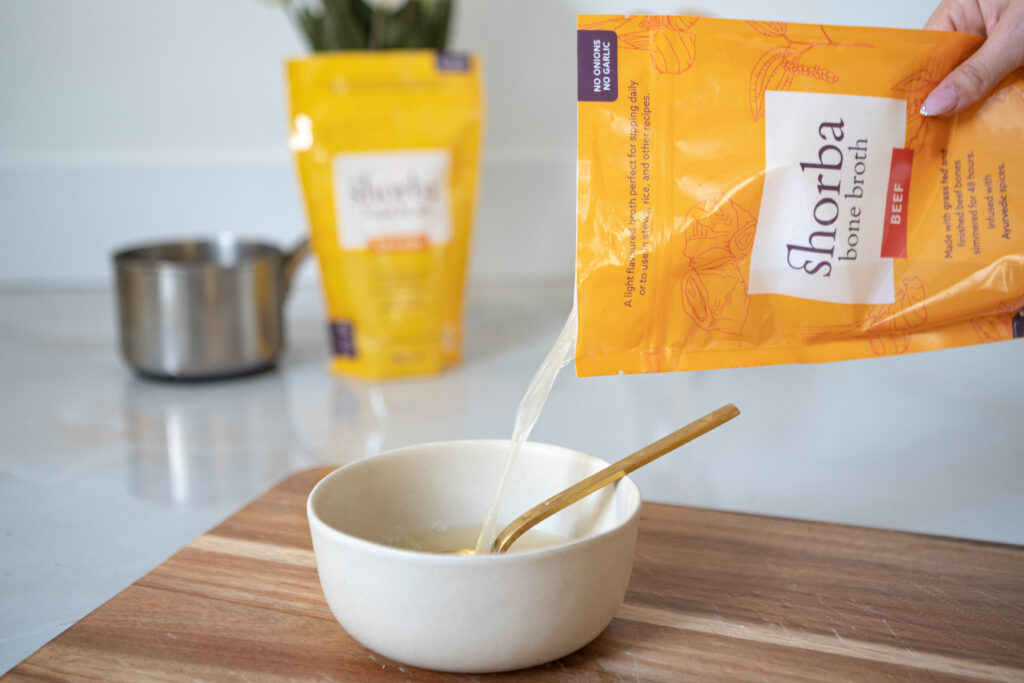The Ultimate Guide to Making and Delighting In Organic Bone Broths at Home
Bone broth has actually obtained attention for its countless health and wellness advantages and culinary adaptability. Crafting natural bone broth in the house allows people to regulate the top quality of active ingredients, making certain a nutritious end result. Understanding the selection of bones, crucial flavor components, and proper food preparation techniques is vital. As the procedure unravels, one might ask yourself just how to raise their broth beyond the essentials and include it into daily dishes for enhanced flavor and nourishment.
Comprehending the Health Conveniences of Bone Brew
Bone brew has actually been a staple in numerous foods for centuries, its wellness advantages have acquired considerable interest in recent years. Rich in collagen, amino acids, and minerals, bone broth is often promoted for its possible to support joint health, enhance digestive tract feature, and improve skin flexibility. The jelly originated from prepared bones might assist digestion and help seal the digestive tract lining, potentially minimizing issues like dripping gut syndrome.Furthermore, the presence of nutrients such as glucosamine and chondroitin may contribute to reduced inflammation and pain relief in joints. In addition, bone brew is hydrating and can serve as a nutritious base for stews and soups. Lots of proponents also assert that it enhances the body immune system, thanks to its mineral profile. On the whole, the resurgence of interest in bone broth is linked to its viewed capability to promote total wellness and support various physical functions.
Choosing the Right Bones for Optimum Flavor and Nourishment
What elements should one take into consideration when choosing bones for brew preparation? The type of bones made use of considerably impacts both taste and nutritional worth. Initially, it is vital to choose bones that consist of a mix of marrow bones, joint bones, and meaty bones. Marrow bones offer rich tastes and healthy fats, while joint bones contribute collagen, boosting the brew's dietary profile.Additionally, sourcing bones from pasture-raised or grass-fed animals warranties higher high quality and more nutrients, as these pets are generally much healthier. The freshness of the bones is also crucial; picking bones from regional butchers or farmers' markets can assure suitable flavor. Bone dimension matters as well; larger bones launch more jelly, leading to a richer brew. Finally, considering the kind of pet-- beef, hen, or fish-- can affect the last preference, enabling for flexible brew options tailored to private choices.
Important Ingredients for a Savory Bone Brew

Quality Bone Choice
The structure of a delicious bone broth lies in the careful selection of top notch bones. Sourcing organic, grass-fed or pasture-raised bones is essential, as these alternatives are much more likely to be totally free from unsafe ingredients and give premium nutrients. Selections such as beef, poultry, or lamb bones each impart distinct tastes and health advantages. Bone types, consisting of marrow bones, knuckle bones, and oxtails, add jelly and collagen, boosting the broth's appearance. Picking bones with a mix of meat and connective cells can additionally include richness and depth. Additionally, choosing bones with visible marrow guarantees a nutrient-dense brew, boosting the general high quality. Ultimately, spending time in top quality bone choice lays the foundation for a scrumptious and beneficial brew.
Aromatic Taste Boosters
Picking premium bones establishes the stage for a rich and nourishing bone brew, however it is the addition of fragrant flavor boosters that truly boosts the meal. Components such as onions, garlic, and carrots not only present sweet taste yet also add deepness to the brew. Fresh natural herbs like thyme, bay, and parsley leaves add an aromatic note, while spices such as black peppercorns and cloves introduce warmth and complexity. Additionally, integrating a dash of apple cider vinegar can aid extract minerals from the bones, enriching the brew. These taste enhancers produce an unified blend, changing a straightforward broth right into a full-flavored foundation for sauces, stews, or soups, making it a flexible component in any culinary repertoire.
Step-by-Step Overview to Making Bone Broth in the house
Producing bone broth in the house can be a gratifying culinary venture that boosts both flavor and nourishment in various recipes. To start, one should pick top notch bones, ideally from natural or grass-fed sources. Roasting the bones at 400 ° F for concerning half an hour can intensify the flavor. Next off, transfer the baked bones to a huge pot or slow-moving stove and cover them with chilly water. Including a dash of vinegar aids essence minerals from the bones.Include aromatic vegetables like onions, carrots, and celery for added deepness, in addition to natural herbs and flavors as wanted. Bring the mixture to a boil, then lower to a simmer. It is important to allow the broth simmer for a minimum of 12 hours, however longer is more suitable for maximum splendor. Lastly, strain the broth via a fine-mesh sieve and shop it in impermeable containers, ready to boost dishes with its nourishing essence.

Tips for Developing Your Bone Brew Simmer
While simmering bone broth, maintaining the appropriate temperature and timing is crucial for accomplishing a delicious and rich result. A mild simmer, preferably between 190 ° F and 210 ° F, aids remove maximum nutrients and tastes without boiling, which can make the brew cloudy. It is a good idea to monitor the pot carefully, changing the warmth as needed to maintain this simmer.Timing is likewise vital; a longer simmer, generally ranging from 12 to 2 days, permits deeper flavor removal and collagen launch. For poultry bones, a 12 to 24-hour simmer is sufficient, while beef bones gain from longer cooking times.Additionally, skimming off any kind of foam or pollutants that climb to the surface area during the initial few hours can improve the broth's clarity and preference. Guaranteeing the pot is covered throughout simmering helps to maintain moisture and intensify the flavors, making for a much more satisfying end product.
Innovative Ways to Use Bone Brew in Your Cooking
Incorporating bone brew into various meals elevates both taste and dietary value. Chefs and home chefs alike locate that utilizing bone brew as a base for soups and stews improves deepness and splendor, transforming easy dishes into hearty dishes. It can also be employed in risottos, where the broth replaces water, allowing the grains to absorb its savory essence.Additionally, bone broth functions as an excellent cooking liquid for grains like quinoa or rice, instilling them with nutrients and taste. For an included spin, it can be utilized in braising meats, leading to tender, flavorful outcomes. Even sauces benefit from a splash of bone brew, enriching their preference profile.Moreover, bone brew can be integrated right into special info smoothie mixes for an unexpected health and wellness boost, supplying protein and nutrients without endangering preference. These creative applications display the adaptability of bone broth in everyday food preparation, making it an important kitchen staple.
Keeping and Preserving Your Home Made Bone Brew
Correct storage space and conservation of homemade bone brew is crucial for preserving its taste and nutritional benefits. Freezing strategies and refrigeration finest practices play an important duty in expanding the broth's shelf life. Recognizing these approaches can assist assure that the broth stays delicious and risk-free for future usage.

Icing Up Methods Clarified
Freezing methods are essential for successfully saving and protecting self-made bone brew, ensuring its rich flavors and nutrients remain undamaged for future use. To ice up bone brew, it is advisable to allow it great totally before moving it to storage space containers. Glass jars, silicone molds, or durable fridge freezer bags appropriate alternatives. When utilizing containers, leave space at the top for expansion throughout freezing. Portioning the brew right into smaller sized amounts permits easy thawing and reduces waste. Label containers with the day and components for easy recognition. For peak top quality, take in the frozen broth within three to 6 months - Organic Bone Broths. Thawing can be carried out in the refrigerator or by utilizing a microwave, making sure that the brew is warmed thoroughly prior to consumption
Refrigeration Best Practices
While several emphasis on freezing as a method of conservation, refrigeration also plays an important function in saving homemade bone brew properly. Once cooled, bone brew ought to be moved to airtight containers, ensuring marginal air exposure to stop putridity. It is suggested to refrigerate broth within two hours of cooking to preserve its high quality. Normally, homemade bone brew can be stored in the refrigerator for as much as 5 days. Labeling containers with dates can assist track about his quality. For peak taste and safety, broth must be reheated to a moving boil before consumption. If longer storage space is called for, freezing stays an outstanding alternative, but appropriate refrigeration methods guarantee that bone broth stays nourishing and delicious for short-term use.
Regularly Asked Inquiries
Can I Make Use Of Frozen Bones for Making Bone Brew?
The inquiry of making use of icy bones for bone brew emerges often (Organic Bone Broths). Specialists agree that frozen bones can be made use of properly, but they need to be defrosted before food preparation to guarantee ideal taste and nutrient extraction
Just How Lengthy Can I Shop Homemade Bone Broth?

Is It Safe to Reheat Bone Brew Several Times?
Reheating bone brew several times can present security concerns - Benefits Of Bone Broth. Each reheating cycle raises the danger of microbial development. It is a good idea to reheat just when and save any type of leftovers immediately to guarantee safety and security and high quality
Can I Add Veggies to the Brew for Taste?
Adding veggies to broth improves taste and nutritional worth. Usual choices consist of carrots, onions, and celery. The vegetables instill their essence right into the brew, producing a richer and a lot more tasty end product.
What's the very best Means to Defrost Frozen Bone Broth?
To defrost icy bone brew, one can place it in the refrigerator over night, make more tips here use of a microwave on low warmth, or submerge the secured container in cozy water, guaranteeing even defrosting without endangering flavor or nutrients. It is vital to select bones that consist of a mix of marrow bones, joint bones, and meaningful bones. Marrow bones give healthy fats and rich flavors, while joint bones contribute collagen, enhancing the brew's nutritional profile.Additionally, sourcing bones from grass-fed or pasture-raised animals guarantees greater quality and more nutrients, as these animals are generally much healthier. Bone kinds, consisting of marrow bones, knuckle bones, and oxtails, contribute gelatin and collagen, enhancing the broth's texture. Choosing top notch bones sets the phase for a healthy and abundant bone broth, but it is the addition of aromatic taste boosters that truly boosts the dish. Also sauces profit from a sprinkle of bone broth, improving their preference profile.Moreover, bone brew can be included into smoothie mixes for an unforeseen health boost, giving healthy protein and nutrients without endangering taste.